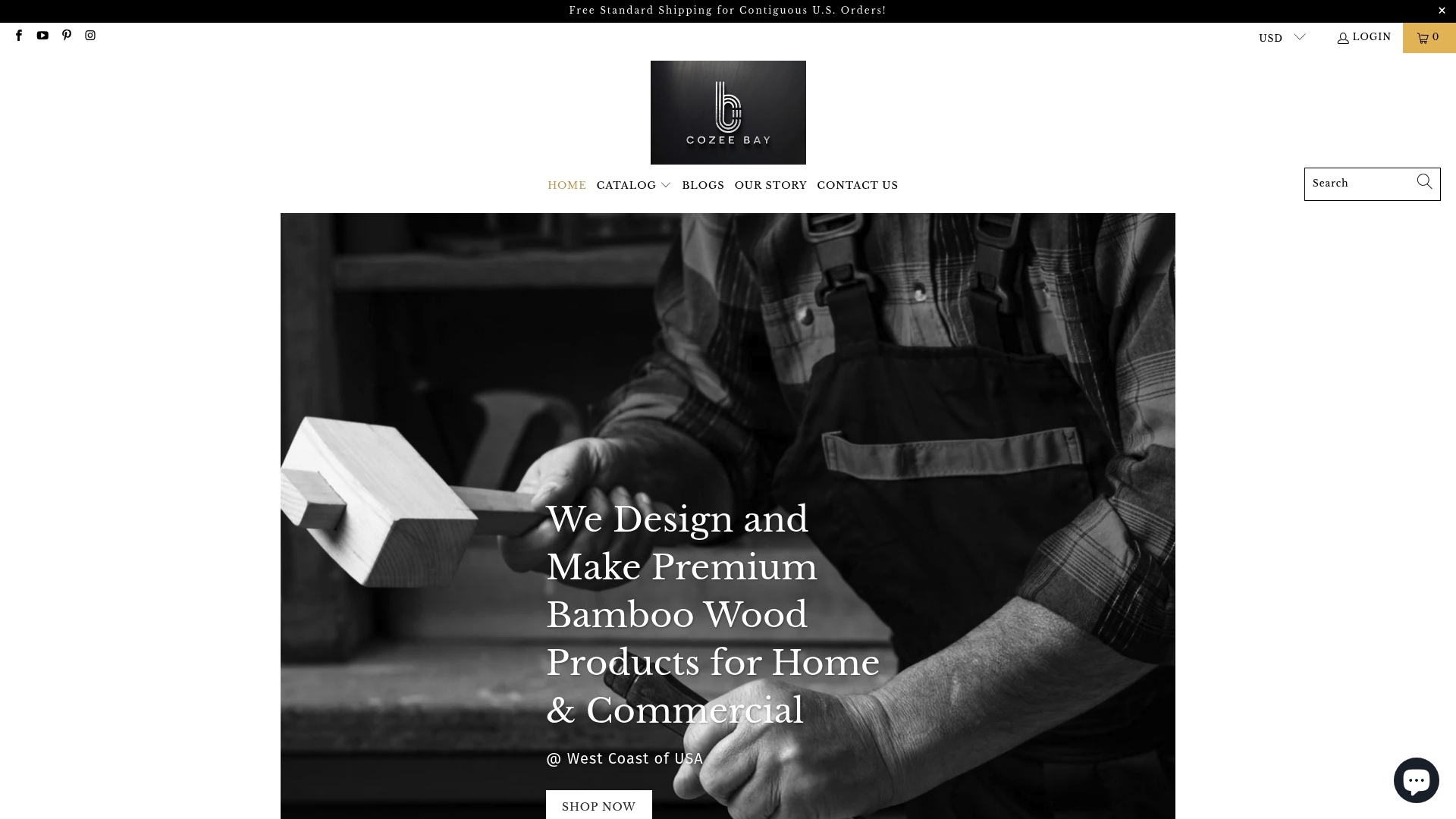Your Cart is Empty
Free Standard Shipping for Contiguous U.S. Orders!
Free Standard Shipping for Contiguous U.S. Orders!
Catalog
What Is Bamboo Wood? Complete Guide to Uses and Benefits
October 21, 2025 6 min read
Did you know that some bamboo species can reach a staggering 3 feet of growth in a single day? This unique plant stands out not only for its speed but also for its role as one of nature’s most sustainable resources. As more people look for eco-friendly alternatives in construction and design, bamboo is becoming a popular choice thanks to its strength, versatility, and minimal impact on the environment.
Table of Contents
- Defining Bamboo Wood And Its Origins
- Types Of Bamboo Used For Wood Products
- Key Properties And Advantages Of Bamboo Wood
- Sustainability And Environmental Impact
- Common Uses In Residential And Commercial Spaces
Key Takeaways
| Point | Details |
|---|---|
| Bamboo Characteristics | Bamboo is a fast-growing grass, reaching maturity in 3-5 years, making it a sustainable alternative to traditional wood. |
| Key Bamboo Species | Notable species like Dendrocalamus asper and Phyllostachys edulis are highly valued for their strength and versatility in wood product applications. |
| Environmental Benefits | Bamboo contributes to carbon sequestration and soil conservation, positioning it as a responsible choice for eco-conscious design. |
| Diverse Applications | Bamboo is increasingly used in both residential and commercial design, providing aesthetic appeal and structural integrity in various products. |
Defining Bamboo Wood and Its Origins
Bamboo is a remarkable woody grass belonging to the Poaceae family, characterized by its extraordinary versatility and rapid growth. According to the FAO Forestry Research, this ancient plant encompasses over 1,600 diverse species distributed across tropical, subtropical, and mild temperate zones, with significant natural presence in Asia, Africa, and the Americas.
Unlike traditional wood derived from trees, bamboo is technically a grass that grows incredibly fast, making it a sustainable alternative in construction, design, and manufacturing. Exploring bamboo’s unique characteristics reveals its remarkable properties:
- Grows up to 3 feet per day in ideal conditions
- Reaches maturity within 3-5 years (compared to 20-50 years for most trees)
- Naturally regenerates without requiring replanting
- Provides robust structural integrity similar to hardwoods
Originally prevalent in regions like South Asia, Southeast Asia, and East Asia, bamboo has been integral to cultural practices and economic systems for thousands of years. Its incredible adaptability and sustainability have transformed it from a regional resource to a global solution for eco-conscious design and manufacturing.
Types of Bamboo Used for Wood Products
When it comes to wood products, not all bamboo species are created equal. According to research from Australian Agriculture, several key bamboo species stand out for their exceptional wood-based applications, including Bambusa, Dendrocalamus, and Phyllostachys genera, which are widely utilized in fencing, crafting, and structural components.
Structural Bamboo Species dominate the wood product landscape with unique characteristics:
- Dendrocalamus asper (Iron bamboo): Known for exceptional strength, prevalent in Southeast Asian construction
- Guadua angustifolia: Popular in Latin American architectural and furniture design
- Phyllostachys edulis (Moso bamboo): Prized Chinese species used extensively in commercial bamboo product applications
Each species offers distinct properties that make them suitable for different wood product applications.
Moso bamboo, for instance, is renowned for its rapid growth and superior structural integrity, making it a favorite among manufacturers seeking sustainable and robust material options.
Here’s a comparison of the most commonly used bamboo species for wood products:
| Species | Geographic Origin | Key Characteristics |
|---|---|---|
| Dendrocalamus asper | Southeast Asia | High strength Used in construction |
| Guadua angustifolia | Latin America | Large size Favored for architecture |
| Phyllostachys edulis | China, East Asia | Fast growth Preferred for flooring |
| Bambusa (Various species) | Asia, Africa, Americas | Versatile uses Fencing and crafts |
| The diversity of bamboo species ensures that designers and builders can select the most appropriate type for specific project requirements, from lightweight decorative elements to heavy-duty structural components. |
Key Properties and Advantages of Bamboo Wood
Bamboo stands out as a remarkable natural composite material with extraordinary physical properties. According to Wikipedia research, bamboo possesses an impressive strength-to-weight ratio that rivals traditional timber, making it an exceptional choice for various structural and design applications.
The key advantages of bamboo wood include:
- Exceptional strength and durability
- Rapid renewable growth cycle
- Natural resistance to moisture and warping
- Lightweight yet robust structural integrity
- Aesthetic versatility for multiple design applications
Engineered bamboo products take these natural advantages even further. Understanding why bamboo for home products matters reveals that modern manufacturing techniques have transformed bamboo into high-performance materials. Engineered bamboo plywood and flooring offer remarkable durability, resistance to cracking, and an elegant aesthetic that challenges traditional hardwood alternatives. Its unique combination of strength, sustainability, and visual appeal makes bamboo an increasingly popular choice for environmentally conscious designers and homeowners seeking both performance and ecological responsibility.
Sustainability and Environmental Impact
Bamboo represents a remarkable solution to environmental challenges, offering unprecedented sustainability benefits. According to the FAO Forestry Research, bamboo plays a critical role in ecological restoration by effectively conserving soil and water, controlling erosion, and adapting to changing climate conditions.
Key Environmental Advantages of bamboo include:
- Rapid carbon sequestration
- Extensive land restoration capabilities
- Minimal water consumption
- Natural soil protection mechanism
- Low environmental footprint compared to traditional timber
Understanding the reasons to choose bamboo for sustainability reveals its extraordinary growth potential. As documented by Wikipedia research, some bamboo species can grow an astonishing 91 cm within just 24 hours, making it an exceptional renewable resource. This incredible growth rate positions bamboo as a powerful tool for afforestation, carbon capture, and mitigating climate change impacts. By rapidly regenerating and requiring minimal agricultural inputs, bamboo offers an environmentally responsible alternative to traditional wood products, supporting global sustainability efforts.
Common Uses in Residential and Commercial Spaces
Bamboo has emerged as a versatile material transforming both residential and commercial interior design landscapes. According to Wikipedia research, bamboo’s economic and cultural significance extends far beyond traditional applications, making it a revolutionary material for modern spaces.
Residential Applications include:
- Kitchen cabinetry and countertops
- Flooring and wall paneling
- Furniture design
- Decorative accessories
- Storage and organizational solutions
Understanding commercial bamboo product uses reveals the material’s remarkable adaptability. Engineered bamboo products have become increasingly popular in commercial settings, offering durability and aesthetic appeal in spaces ranging from offices and restaurants to hotels and retail environments. Design Horizons research highlights bamboo’s potential in creating sophisticated interior wall panels, furniture, and cabinetry that combine structural integrity with environmental consciousness. Its natural beauty and sustainable profile make bamboo an ideal choice for professionals seeking both style and ecological responsibility in their design solutions.
Ready to Experience the Real Benefits of Bamboo Wood in Your Space?
Are you searching for a sustainable solution that truly combines strength, style, and eco-friendliness? After learning about bamboo wood’s rapid renewal, durability, and positive environmental impact in our guide, you may be wondering where to find real products that harness all these advantages for your own home or business. Many people struggle to find bamboo products that genuinely deliver on promises of quality and sustainability. At Cozee Bay, we have solved this with our expertly crafted bamboo wood essentials, including our best-selling paper towel dispensers recognized in residential and commercial places for their lasting performance and elegant design.

Upgrade your daily environment with our premium handcrafted bamboo paper towel dispensers or explore even more sustainable home and organizational solutions for kitchens, offices, or any public space. Discover for yourself why so many eco-conscious individuals choose us for a cleaner, greener future. Visit Cozee Bay to shop now while free shipping is available across the contiguous U.S. Your journey toward responsible style and superior function starts today.
Frequently Asked Questions
What is bamboo wood and how is it different from traditional wood?
Bamboo wood is a material derived from bamboo, a fast-growing woody grass, making it a sustainable alternative to traditional timber from trees. Unlike typical wood, bamboo matures much quicker, usually within 3-5 years, and exhibits strength comparable to hardwoods.
What are the key benefits of using bamboo wood for construction and design?
Bamboo wood offers several advantages, including exceptional strength and durability, a rapid growth cycle that enhances sustainability, natural resistance to moisture, and aesthetic versatility suitable for various design applications.
How is bamboo wood used in residential and commercial spaces?
Bamboo wood is used in various ways in both residential and commercial spaces, including kitchen cabinetry, flooring, wall paneling, furniture design, and decorative accessories. Its engineered products are particularly popular for their durability and aesthetic appeal in diverse environments.
What are the environmentally friendly properties of bamboo wood?
Bamboo wood has numerous environmental benefits, such as rapid carbon sequestration, erosion control, minimal water consumption, and a low environmental footprint compared to traditional timber. Its ability to regenerate quickly positions it as a sustainable resource for combating climate change.
Recommended
- Cozee Bay - Complete Guide to Bamboo vs Traditional Wood
- Cozee Bay - Understanding the Benefits of Bamboo for Homes
- Cozee Bay - Understanding the Eco Impact of Bamboo in Sustainable Living
- Cozee Bay - Understanding the Benefits of Bamboo Products
- 7 Types of Sustainable Materials for Eco-Friendly Living – The Cork Store
Leave a comment
Comments will be approved before showing up.
Subscribe
Sign up to get the latest on sales, new releases and more …

